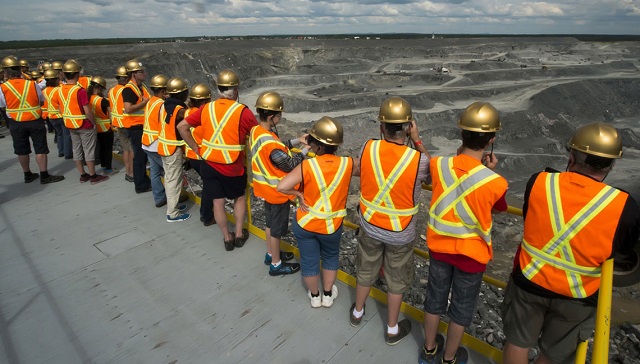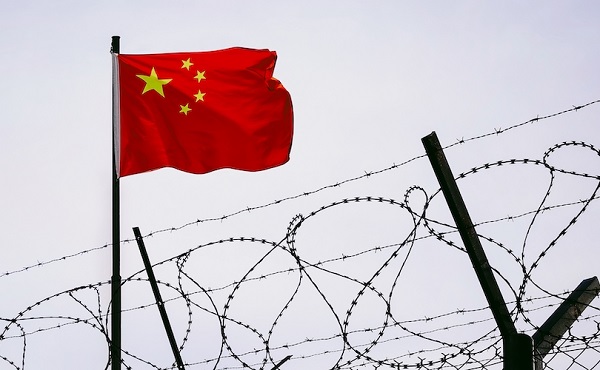Business
Canada’s productivity and prosperity slump

From Resource Works
“The U.S. is on track to produce nearly 50 percent more per person than Canada will. This stunning divergence is unprecedented in modern history.”
National productivity is key to our personal prosperity and standard of living—and we’re in trouble.
Canada’s productivity, a measure of our efficiency in producing goods and services, has been seriously slumping for years, and we are now one of the least productive G7 nations.
Now, business leaders say part of the solution could, and should, lie in producing natural resources and supercharging the resource sector.
The Royal Bank of Canada reports: “The Canadian economy has continued to underperform global peers. Declines in per-capita output in seven of the last eight quarters have left average income per person back at decade-ago levels, and the unemployment rate has risen more than in other advanced economies.
“Canada is not ‘officially’ in a recession… but per-capita gross domestic product and the unemployment rate are more representative of what individual households and workers are experiencing in the current economy, and on that basis, it certainly feels like one.”
Now, a new report by the Canadian Chamber of Commerce says a comprehensive national strategy is needed to promote resource investments.
“We really need to lean into our strengths as a country,” says report author Andrew DiCapua. “We are lucky to live in a country where we have abundant natural resources… We should be trying to find ways to attract investment to supercharge the sector.”
Senior economist DiCapua notes: “With Canada facing significant economic challenges—below-trend growth, declining living standards, regulatory uncertainty, and weak business investment—the Canadian economy is not keeping pace.
“The main recommendation here is to create regulations and policies that provide regulatory certainty—or rather clarity—so that investment can be attracted into this crucial (natural-resource) sector.”
The national business group says the new approach should include streamlining government regulations, recognizing the need for timely approval of major projects, and ensuring policy stability.
It also recommends speeding up the delivery of investment tax credits for projects that cut emissions and adopting a trade infrastructure plan to ensure the country has sufficient roads, ports, and energy transmission lines for accessing resources in remote areas.
The Chamber notes that the natural-resources sector is the second-largest in Canada, paying compensation last year that was $25,000 more than the national average.
“The sector can do this because of its productivity prowess, which is closely linked to the country’s prosperity and long-term standard of living. This is why increasing investment in high-productivity sectors, particularly within natural resources, is an obvious remedy to our productivity challenges.”
And it adds: “Given the natural resources sector’s higher-than-average Indigenous workforce participation, higher wage opportunities can help increase Indigenous employment and economic participation, furthering economic reconciliation efforts by supporting Indigenous-owned businesses, equity partnerships, and employment.”
Economists, business leaders, and the Bank of Canada have highlighted the country’s productivity woes for years—and the level of concern is growing.
As TD Economics pointed out in a worrisome report: “Canadians’ standard of living, as measured by real GDP per person, was lower in 2023 than in 2014.
“Without improved productivity growth, workers will face stagnating wages, and government revenues will not keep pace with spending commitments, requiring higher taxes or reduced public services.”
And: “Over the decade prior to the pandemic, business sector productivity grew at a respectable rate of 1.2% annually. Since 2019, it has ceased to expand at all, setting Canada apart as one of the worst-performing advanced economies, not to mention in stark contrast to the United States…
“The woes are widespread. Relative to growth in the decade prior to the pandemic, only a few service industries have managed to improve their performance… To get the same output, it now requires more hours from workers. Hard to believe this could occur in a digital age.”
Economist Trevor Tombe of the University of Calgary states: “The gap between the Canadian and American economies has now reached its widest point in nearly a century.
“If this continues, we’ll not have persistently seen this wide of a gap since the days of John A. Macdonald… Taking bolder action to address this growing prosperity gap is needed. And fast.
“The U.S. is on track to produce nearly 50 percent more per person than Canada will. This stunning divergence is unprecedented in modern history.”
Earlier this year, Carolyn Rogers, senior deputy governor of the Bank of Canada, gave this warning on our productivity: “You’ve seen those signs that say, ‘In emergency, break glass.’ Well, it’s time to break the glass.”
Rogers said in a Halifax speech: “An economy with low productivity can grow only so quickly before inflation sets in. But an economy with strong productivity can have faster growth, more jobs, and higher wages with less risk of inflation…
“We thought productivity would improve coming out of the pandemic as firms found their footing and workers trained back up. We’ve seen that happen in the US economy, but it hasn’t happened here. In fact, the level of productivity in Canada’s business sector is more or less unchanged from where it was seven years ago.”
It’s beyond time for our federal and provincial governments to get in gear and take steps to help get our productivity back on track.
The Chamber of Commerce’s recommendations would be a good place to start: adopt sensible regulations and stable policies that encourage investment in our natural resources, and speed up the approval of major projects.
Business
Some Of The Wackiest Things Featured In Rand Paul’s New Report Alleging $1,639,135,969,608 In Gov’t Waste


From the Daily Caller News Foundation
Republican Kentucky Sen. Rand Paul released the latest edition of his annual “Festivus” report Tuesday detailing over $1 trillion in alleged wasteful spending in the U.S. government throughout 2025.
The newly released report found an estimated $1,639,135,969,608 total in government waste over the past year. Paul, a prominent fiscal hawk who serves as the chairman of the Senate Homeland Security and Governmental Affairs Committee, said in a statement that “no matter how much taxpayer money Washington burns through, politicians can’t help but demand more.”
“Fiscal responsibility may not be the most crowded road, but it’s one I’ve walked year after year — and this holiday season will be no different,” Paul continued. “So, before we get to the Feats of Strength, it’s time for my Airing of (Spending) Grievances.”
Dear Readers:
As a nonprofit, we are dependent on the generosity of our readers.
Please consider making a small donation of any amount here.
Thank you!
The 2025 “Festivus” report highlighted a spate of instances of wasteful spending from the federal government, including the Department of Health and Human Services (HHS) spent $1.5 million on an “innovative multilevel strategy” to reduce drug use in “Latinx” communities through celebrity influencer campaigns, and also dished out $1.9 million on a “hybrid mobile phone family intervention” aiming to reduce childhood obesity among Latino families living in Los Angeles County.
The report also mentions that HHS spent more than $40 million on influencers to promote getting vaccinated against COVID-19 for racial and ethnic minority groups.
The State Department doled out $244,252 to Stand for Peace in Islamabad to produce a television cartoon series that teaches children in Pakistan how to combat climate change and also spent $1.5 million to promote American films, television shows and video games abroad, according to the report.
The Department of Veterans Affairs (VA) spent more than $1,079,360 teaching teenage ferrets to binge drink alcohol this year, according to Paul’s report.
The report found that the National Science Foundation (NSF) shelled out $497,200 on a “Video Game Challenge” for kids. The NSF and other federal agencies also paid $14,643,280 to make monkeys play a video game in the style of the “Price Is Right,” the report states.
Paul’s 2024 “Festivus” report similarly featured several instances of wasteful federal government spending, such as a Las Vegas pickleball complex and a cabaret show on ice.
The Trump administration has been attempting to uproot wasteful government spending and reduce the federal workforce this year. The administration’s cuts have shrunk the federal workforce to the smallest level in more than a decade, according to recent economic data.
Festivus is a humorous holiday observed annually on Dec. 23, dating back to a popular 1997 episode of the sitcom “Seinfeld.” Observance of the holiday notably includes an “airing of grievances,” per the “Seinfeld” episode of its origin.
Alberta
A Christmas wish list for health-care reform

From the Fraser Institute
By Nadeem Esmail and Mackenzie Moir
It’s an exciting time in Canadian health-care policy. But even the slew of new reforms in Alberta only go part of the way to using all the policy tools employed by high performing universal health-care systems.
For 2026, for the sake of Canadian patients, let’s hope Alberta stays the path on changes to how hospitals are paid and allowing some private purchases of health care, and that other provinces start to catch up.
While Alberta’s new reforms were welcome news this year, it’s clear Canada’s health-care system continued to struggle. Canadians were reminded by our annual comparison of health care systems that they pay for one of the developed world’s most expensive universal health-care systems, yet have some of the fewest physicians and hospital beds, while waiting in some of the longest queues.
And speaking of queues, wait times across Canada for non-emergency care reached the second-highest level ever measured at 28.6 weeks from general practitioner referral to actual treatment. That’s more than triple the wait of the early 1990s despite decades of government promises and spending commitments. Other work found that at least 23,746 patients died while waiting for care, and nearly 1.3 million Canadians left our overcrowded emergency rooms without being treated.
At least one province has shown a genuine willingness to do something about these problems.
The Smith government in Alberta announced early in the year that it would move towards paying hospitals per-patient treated as opposed to a fixed annual budget, a policy approach that Quebec has been working on for years. Albertans will also soon be able purchase, at least in a limited way, some diagnostic and surgical services for themselves, which is again already possible in Quebec. Alberta has also gone a step further by allowing physicians to work in both public and private settings.
While controversial in Canada, these approaches simply mirror what is being done in all of the developed world’s top-performing universal health-care systems. Australia, the Netherlands, Germany and Switzerland all pay their hospitals per patient treated, and allow patients the opportunity to purchase care privately if they wish. They all also have better and faster universally accessible health care than Canada’s provinces provide, while spending a little more (Switzerland) or less (Australia, Germany, the Netherlands) than we do.
While these reforms are clearly a step in the right direction, there’s more to be done.
Even if we include Alberta’s reforms, these countries still do some very important things differently.
Critically, all of these countries expect patients to pay a small amount for their universally accessible services. The reasoning is straightforward: we all spend our own money more carefully than we spend someone else’s, and patients will make more informed decisions about when and where it’s best to access the health-care system when they have to pay a little out of pocket.
The evidence around this policy is clear—with appropriate safeguards to protect the very ill and exemptions for lower-income and other vulnerable populations, the demand for outpatient healthcare services falls, reducing delays and freeing up resources for others.
Charging patients even small amounts for care would of course violate the Canada Health Act, but it would also emulate the approach of 100 per cent of the developed world’s top-performing health-care systems. In this case, violating outdated federal policy means better universal health care for Canadians.
These top-performing countries also see the private sector and innovative entrepreneurs as partners in delivering universal health care. A relationship that is far different from the limited individual contracts some provinces have with private clinics and surgical centres to provide care in Canada. In these other countries, even full-service hospitals are operated by private providers. Importantly, partnering with innovative private providers, even hospitals, to deliver universal health care does not violate the Canada Health Act.
So, while Alberta has made strides this past year moving towards the well-established higher performance policy approach followed elsewhere, the Smith government remains at least a couple steps short of truly adopting a more Australian or European approach for health care. And other provinces have yet to even get to where Alberta will soon be.
Let’s hope in 2026 that Alberta keeps moving towards a truly world class universal health-care experience for patients, and that the other provinces catch up.
-

 International1 day ago
International1 day agoGeorgia county admits illegally certifying 315k ballots in 2020 presidential election
-

 Digital ID2 days ago
Digital ID2 days agoCanadian government launches trial version of digital ID for certain licenses, permits
-

 International1 day ago
International1 day agoCommunist China arrests hundreds of Christians just days before Christmas
-

 Business2 days ago
Business2 days agoThe “Disruptor-in-Chief” places Canada in the crosshairs
-

 Business20 hours ago
Business20 hours agoSome Of The Wackiest Things Featured In Rand Paul’s New Report Alleging $1,639,135,969,608 In Gov’t Waste
-

 Alberta1 day ago
Alberta1 day agoCalgary’s new city council votes to ban foreign flags at government buildings
-

 Business1 day ago
Business1 day agoWarning Canada: China’s Economic Miracle Was Built on Mass Displacement
-

 Energy10 hours ago
Energy10 hours agoThe Top News Stories That Shaped Canadian Energy in 2025 and Will Continue to Shape Canadian Energy in 2026



